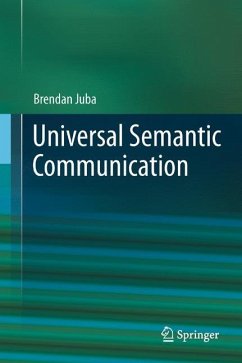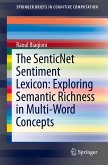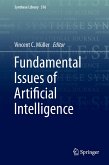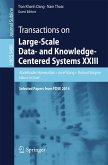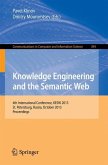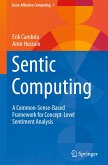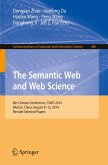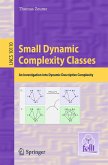Is meaningful communication possible between two intelligent parties who share no common language or background? In this work, a theoretical framework is proposed in which it is possible to address when and to what extent such semantic communication is possible: such problems can be rigorously addressed by explicitly focusing on the goals of the communication. Under this framework, it is possible to show that for many goals, communication without any common language or background is possible using universal protocols.
This work should be accessible to anyone with an undergraduate-level knowledge of the theory of computation. The theoretical framework presented here is of interest to anyone wishing to design systems with flexible interfaces, either among computers or between computers and their users.
This work should be accessible to anyone with an undergraduate-level knowledge of the theory of computation. The theoretical framework presented here is of interest to anyone wishing to design systems with flexible interfaces, either among computers or between computers and their users.
"The problem considered by this book is how two agents can successfully communicate in the absence of a prior agreement on the protocol to be used. Specific examples of potential applications include interfacing with device drivers and adapting to changing network protocols ... The ideas in the book are important and deserve to be well known." (J.P.E. Hodgson, ACM Computing Reviews, July 2012)
"This work initiates and formulates a new research direction and provides initial results about this direction. Specifically, it puts forward a general theory of goal-oriented communication, where the focus is not on the raw data being communicated but rather on the goal being achieved by the communication. The work is of fundamental nature, its essence being a novel mathematical theory that attempts to capture a key aspect in communication: its meaning." Oded Goldreich (Weizmann Institute)
"The question 'How do humans associate meaning to words?' has confounded many scholars from various disciplines, including linguistics, philosophy, psychology and media studies. This book introduces a new discipline to this list: mathematics. It attempts to frame the question 'What is the meaning of symbols?' in a totally mathematical way, using notions from the theory of computer science to formalize concepts that otherwise seem elusive. In the process it produces a formalism that not only suggests how humans may associate meaning to words, but how even a computer may associate meaning to bits. The formalism is not easy to obtain, but with a question as deep as this we should not expect easy formalisms but rather careful, correct ones.
This book produces about as careful a formalism as one can hope for at the current state of understanding. It produces a theory that formalizes many of the themes seen in prior explorations of this question, thereby solidifying the foundations. On the other hand, it also suggests ways in which such mathematical formalisms may influence technology questions. For example, it describes how Internet communication protocols may be allowed to 'evolve organically' while maintaining functionality, a strong departure from current practice -- communicating players simply learn the new protocol as if they were learning a new language. This will surely be the future of computer-to-computer communication, and the book provides a glimpse of the first steps in this exciting path." Madhu Sudan (Microsoft Research New England Lab)
"This work initiates and formulates a new research direction and provides initial results about this direction. Specifically, it puts forward a general theory of goal-oriented communication, where the focus is not on the raw data being communicated but rather on the goal being achieved by the communication. The work is of fundamental nature, its essence being a novel mathematical theory that attempts to capture a key aspect in communication: its meaning." Oded Goldreich (Weizmann Institute)
"The question 'How do humans associate meaning to words?' has confounded many scholars from various disciplines, including linguistics, philosophy, psychology and media studies. This book introduces a new discipline to this list: mathematics. It attempts to frame the question 'What is the meaning of symbols?' in a totally mathematical way, using notions from the theory of computer science to formalize concepts that otherwise seem elusive. In the process it produces a formalism that not only suggests how humans may associate meaning to words, but how even a computer may associate meaning to bits. The formalism is not easy to obtain, but with a question as deep as this we should not expect easy formalisms but rather careful, correct ones.
This book produces about as careful a formalism as one can hope for at the current state of understanding. It produces a theory that formalizes many of the themes seen in prior explorations of this question, thereby solidifying the foundations. On the other hand, it also suggests ways in which such mathematical formalisms may influence technology questions. For example, it describes how Internet communication protocols may be allowed to 'evolve organically' while maintaining functionality, a strong departure from current practice -- communicating players simply learn the new protocol as if they were learning a new language. This will surely be the future of computer-to-computer communication, and the book provides a glimpse of the first steps in this exciting path." Madhu Sudan (Microsoft Research New England Lab)
"This work initiates and formulates a new research direction and provides initial results about this direction. Specifically, it puts forward a general theory of goal-oriented communication, where the focus is not on the raw data being communicated but rather on the goal being achieved by the communication. The work is of fundamental nature, its essence being a novel mathematical theory that attempts to capture a key aspect in communication: its meaning." -- Oded Goldreich (Weizmann Institute)
"The question 'How do humans associate meaning to words?' has confounded many scholars from various disciplines, including linguistics, philosophy, psychology and media studies. This book introduces a new discipline to this list: mathematics. It attempts to frame the question 'What is the meaning of symbols?' in a totally mathematical way, using notions from the theory of computer science to formalize concepts that otherwise seem elusive. In the process it produces a formalism that not only suggests how humans may associate meaning to words, but how even a computer may associate meaning to bits. The formalism is not easy to obtain, but with a question as deep as this we should not expect easy formalisms but rather careful, correct ones.
This book produces about as careful a formalism as one can hope for at the current state of understanding. It produces a theory that formalizes many of the themes seen in prior explorations of this question, thereby solidifying the foundations. On the other hand, it also suggests ways in which such mathematical formalisms may influence technology questions. For example, it describes how Internet communication protocols may be allowed to 'evolve organically' while maintaining functionality, a strong departure from current practice -- communicating players simply learn the new protocol as if they were learning a new language. This will surely be the future of computer-to-computer communication, and the book provides a glimpse of the first steps in this exciting path." -- Madhu Sudan (Microsoft Research New England Lab
"The question 'How do humans associate meaning to words?' has confounded many scholars from various disciplines, including linguistics, philosophy, psychology and media studies. This book introduces a new discipline to this list: mathematics. It attempts to frame the question 'What is the meaning of symbols?' in a totally mathematical way, using notions from the theory of computer science to formalize concepts that otherwise seem elusive. In the process it produces a formalism that not only suggests how humans may associate meaning to words, but how even a computer may associate meaning to bits. The formalism is not easy to obtain, but with a question as deep as this we should not expect easy formalisms but rather careful, correct ones.
This book produces about as careful a formalism as one can hope for at the current state of understanding. It produces a theory that formalizes many of the themes seen in prior explorations of this question, thereby solidifying the foundations. On the other hand, it also suggests ways in which such mathematical formalisms may influence technology questions. For example, it describes how Internet communication protocols may be allowed to 'evolve organically' while maintaining functionality, a strong departure from current practice -- communicating players simply learn the new protocol as if they were learning a new language. This will surely be the future of computer-to-computer communication, and the book provides a glimpse of the first steps in this exciting path." -- Madhu Sudan (Microsoft Research New England Lab
"The problem considered by this book is how two agents can successfully communicate in the absence of a prior agreement on the protocol to be used. Specific examples of potential applications include interfacing with device drivers and adapting to changing network protocols ... The ideas in the book are important and deserve to be well known." (J.P.E. Hodgson, ACM Computing Reviews, July 2012)
"This work initiates and formulates a new research direction and provides initial results about this direction. Specifically, it puts forward a general theory of goal-oriented communication, where the focus is not on the raw data being communicated but rather on the goal being achieved by the communication. The work is of fundamental nature, its essence being a novel mathematical theory that attempts to capture a key aspect in communication: its meaning." Oded Goldreich (Weizmann Institute)
"The question 'How do humans associate meaning to words?' has confounded many scholars from various disciplines, including linguistics, philosophy, psychology and media studies. This book introduces a new discipline to this list: mathematics. It attempts to frame the question 'What is the meaning of symbols?' in a totally mathematical way, using notions from the theory of computer science to formalize concepts that otherwise seem elusive. In the process it produces a formalism that not only suggests how humans may associate meaning to words, but how even a computer may associate meaning to bits. The formalism is not easy to obtain, but with a question as deep as this we should not expect easy formalisms but rather careful, correct ones.
This book produces about as careful a formalism as one can hope for at the current state of understanding. It produces a theory that formalizes many of the themes seen in prior explorations of this question, thereby solidifying the foundations. On the other hand, it also suggests ways in which such mathematical formalisms may influence technology questions. For example, it describes how Internet communication protocols may be allowed to 'evolve organically' while maintaining functionality, a strong departure from current practice -- communicating players simply learn the new protocol as if they were learning a new language. This will surely be the future of computer-to-computer communication, and the book provides a glimpse of the first steps in this exciting path." Madhu Sudan (Microsoft Research New England Lab)
"This work initiates and formulates a new research direction and provides initial results about this direction. Specifically, it puts forward a general theory of goal-oriented communication, where the focus is not on the raw data being communicated but rather on the goal being achieved by the communication. The work is of fundamental nature, its essence being a novel mathematical theory that attempts to capture a key aspect in communication: its meaning." Oded Goldreich (Weizmann Institute)
"The question 'How do humans associate meaning to words?' has confounded many scholars from various disciplines, including linguistics, philosophy, psychology and media studies. This book introduces a new discipline to this list: mathematics. It attempts to frame the question 'What is the meaning of symbols?' in a totally mathematical way, using notions from the theory of computer science to formalize concepts that otherwise seem elusive. In the process it produces a formalism that not only suggests how humans may associate meaning to words, but how even a computer may associate meaning to bits. The formalism is not easy to obtain, but with a question as deep as this we should not expect easy formalisms but rather careful, correct ones.
This book produces about as careful a formalism as one can hope for at the current state of understanding. It produces a theory that formalizes many of the themes seen in prior explorations of this question, thereby solidifying the foundations. On the other hand, it also suggests ways in which such mathematical formalisms may influence technology questions. For example, it describes how Internet communication protocols may be allowed to 'evolve organically' while maintaining functionality, a strong departure from current practice -- communicating players simply learn the new protocol as if they were learning a new language. This will surely be the future of computer-to-computer communication, and the book provides a glimpse of the first steps in this exciting path." Madhu Sudan (Microsoft Research New England Lab)

